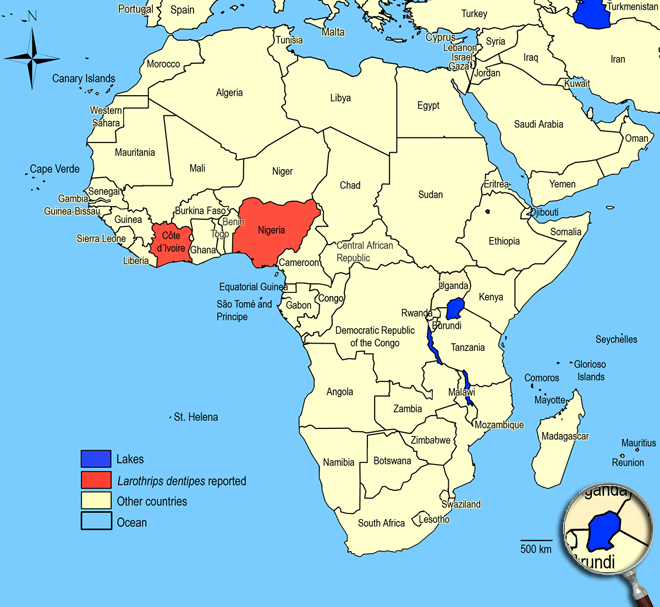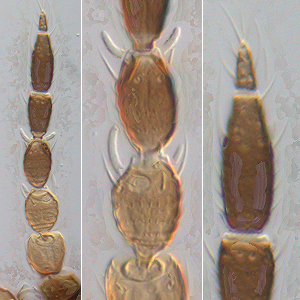Larothrips dentipes Pitkin, 1973
Thripinae, Thripidae, Terebrantia, Thysanoptera
Figures
Fig. 1: 7-segmented antenna, segments III and IV with forked sense cone, terminal segments VI and VII
Fig. 2: Head dorsal with ocellar triangle
Fig. 3: Head and fore legs, tibiae with curved tooth
Fig. 4: Head ventral with mouth cone and fore legs (male)
Fig. 5: Pronotum
Fig. 6: Meso- and metanotum
Fig. 7: Meso- and metanotum (male)
Fig. 8: Fore wing and fore wing basal region
Fig. 9: Sternites IV-VI
Fig. 10: Tergites IV-VI
Fig. 11: Tergites VIII-XI
Introduction and recognition
Larothrips dentipes can be found in yam flowers and is possibly a pollinating agent. Both sexes fully winged. Body color brown; apical two-thirds of antennal segment II, all of segment III, fore tibiae and all tarsi paler or yellow; fore wings uniformly brown except for paler area near the base. Antennae 7-segmented; segments III & IV slightly constricted at apex and with forked sense cone (Fig. 1). Head about as long as wide; with 2 pairs of ocellar setae, pair I absent, pair III small, about as long as pair II and arising just within ocellar triangle; postocular setae I-III about equal to ocellar setae III in length (Fig. 2-4). Pronotum without long setae; posterior margin with about 5-6 pairs of minor setae (Fig. 5). Mesofurca with spinula. Metanotum median area with sculptured lines transverse at anterior, but forming irregular longitudinal reticulations on posterior half; median setae arising behind anterior margin; campaniform sensilla present (Fig. 6 and 7). Mid and hind tarsi 2-segmented; fore femora and fore tibiae enlarged; fore tibiae bearing stout curved claw and small tubercle ventrally at apex (Fig. 4). Fore wing first vein usually with 2 setae on distal half; second vein with a complete row of about 11-15 setae; clavus with 6 marginal setae (Fig. 8). Tergite II with 3 lateral marginal setae; tergites V-VIII with ctenidia present laterally , on VIII posteromedial to spiracles; tergites II-VII with craspedum of unbroken border or flange on posterior margin (Fig. 10); posterior margin of VIII with continuous craspedum medially, but toothlike microtrichia laterally (Fig. 11). Sternites without craspeda; with a single row of 3-7 discal setae; median pair of marginal setae on sternite VII arise at posterior margin (Fig. 9).
Male similar to female, but smaller and pale or yellow (Fig. 4 and 7); tergite VIII without marginal comb of microtrichia, but with craspedum of unbroken border or flange on posterior margin; sternites III-VII usually each with narrow transverse glandular area.
Taxonomic identity
Species
Larothrips dentipes Pitkin, 1973
Taxonomic history
-
Common name
-
Present taxonomic position
Family: Thripidae Stephens, 1829
Subfamily: Thripinae (Stephens) Karny, 1921
Genus: Larothrips Pitkin, 1973
Genus description
The genus Larothrips Pitkin, 1973
Only 1 species are listed in this genus, Larothrips dentipes, from West Africa. It is closely related to the genus Thrips. Together with the genus Thrips ocellar setae I absent and a well developed tergal ctenidia posteromedial to the spiracles on tergite VIII present. But Larothrips dentipes has a distinctive craspedum of unbroken border or flange on the posterior margin of tergites II-VII, and no elongate pronotal setae (Pitkin 1973). Furthermore, Larothrips has 7-segmented antennae with forked sense cone on segments III & IV, a continuous craspedum medially and toothlike microtrichia laterally on tergite VIII, distinctly enlarged fore femora, and fore tibiae with a fore tibial apex bearing a stout curved claw ventrolaterally.
Species description
Typical key character states of Larothrips dentipes
Coloration and body sculpture
Body color: mainly brown to dark brown
Surface of head, pronotum and fore legs: without obvious or with weakly reticulate sculpture
Antennae
Form of sense cones on antennal segments III and IV: emergent and forked on segments III and IV
Number of antennal segments: 7
Antennal segment I: without any setae on dorsal apical margin
Antennal segment II: without an exceptionally long seta at the inner apex
Antennal segment II shape: symmetric
Antennal segment III shape: symmetric
Length of antennal segment III and IV: antennal segment III similar in length to segment IV
Forked sense cone on antennal segment IV: scarcely extending beyond base of segment V
Antennal segment IV and V: without a hyaline ring near the base
Antennal segment VI bears: not a remarkably dagger-shaped sensorium
Head
Distance between bases of ocellar setae III: greater than width of first ocellus
Head: not prolonged in front of compound eyes
Ocellar setae I: absent
Length of ocellar setae II: S2 = S3
Ocellar setae III: arising within ocellar triangle anterior to tangent of anterior margin of hind ocelli
Ocelli: present
Length of postocular setae: not alternating short and long setae
Number of ocellar setae: 2
Prothorax
Number of pairs of long anteroangular setae: 0
Number of pairs of long posteroangular setae: 0
Number of pairs of elongate pronotal setae: 0
Number of pairs of posteromarginal minor setae: 5-6
Pronotal blotch or internal apodeme: absent
Pronotum shape: broadly rectangular
Pronotum posteromarginal/posteroangular setae: S2 longer than S3, not equal in length
Mesothorax
Mesosternal furca: with median spinula
Metathorax
Metanotal campaniform sensilla: present
Metanotal median setae: S1 behind anterior margin
Metanotum with dominant sculptured triangle medially: absent
Metasternal furca: without spinula
Sculpture of metanotum median area: transverse at anterior, but irregular longitudinal or equiangular reticulations on posterior half
Shape of metathoracic furca: transverse, V-shaped
Wings
Fore and hind wings: present, more than half as long as abdomen (macropterous)
Fringe cilia arising: from sockets
Fore wing veins: present
Fore- and hind wing surface: covered with microtrichia
Apex of fore wing: with prominent terminal setae
Fore wing anterior margin (costal vein): with setae and cilia but cilia longer than setae
Fore wing clavus - number of marginal setae: 6
Fore wing costal fringe cilia: arising at anterior margin of wing
Fore wing first vein: distinct from costal vein
Fore wing first vein setal row: incomplete, with setae not closely and uniformly spaced
Fore wing second vein setal row: complete, setae uniformly spaced
Fore wing shape: mainly parallel sided or margins run continuously towards each other
Fore wing surface: not reticulate
Fore wing first vein number of setae on distal half: 2
Fringe cilia on posterior margin near apex: distinctly wavy (undulated)
Length of fore wing costal setae at middle of wing: longer than half of median wing width
Shape of fore wing apex: with mainly posterior margin curved to join anterior margin
Fore wing extreme apex color: dark
Fore wings: uniformly dark or shaded, but with base or sub-base pale
Legs
Fore tibia: not prolonged, but with stout curved claw ventrolaterally
Mid and hind tarsi: with two segments
Color of fore tarsi: pale or yellow, sometimes apical shaded or brown
Abdomen
Pleurotergites: not covered in microtrichia
Sternite II: with marginal setae and few discal setae
Number of discal setae on sternites III to VI: 3-7
Sternites IV, V and VI: with marginal setae and discal setae medially
Sternite VII median posteromarginal setae S1: arising at posterior margin
Sternite VII: with marginal setae and discal setae present on median area
Surface of lateral thirds of abdominal tergites: without regular rows of fine microtrichia
Number of lateral marginal setae on tergite II: 3
Tergites II to VII median setal pair: no more than 0.3 as long as median length of tergite
Craspedum on tergites IV to VI: present, continuous craspedum
Tergites V to VII: with ctenidia laterally
Tergites IV and V median setal pair: shorter than distance between their bases
Craspedum on tergite VIII: with continuos craspedum medially, but toothlike microtrichia laterally
Tergite VIII ctenidia: posteromedial to spiracle
Tergite VIII posteromarginal comb of microtrichia: present with craspedum medially and long microtrichia laterally
Tergite VIII shape of posteromarginal microrichia: long on broadly triangular bases
Tergite X: not tubular, longitudinally incomplete
Setae on abdominal tergite X: all setae slender

Similar or related species
Larothrips dentipes is similar to species of the genera Stenchaetothrips and Thrips, and Fulmekiola serrata and Microcephalothrips abdominalis, because of absence of ocellar setae I, and tergites V-VIII bear a pair of ctenidia laterally, which on tergite VIII arranged posteromedial to the spiracle. Compared to Larothrips dentipes, the species of Stenchaetothrips and Thrips have no posteromarginal craspedum on tergites, and the pronotum usually has 2 pairs of long posteroangular setae. Fulmekiola serrata as well as Microcephalothrips abdominalis and Larothrips dentipes, all of them exhibit a posteromarginal craspedum on tergites, but in Fulmekiola serrata and Microcephalothrips abdominalis the craspedum on tergites II-VII consist of independent triangular lobes or teeth (Microcephalothrips abdominalis) or of medially rounded lobes fused at base and laterally large independent teeth (Fulmekiola serrata). Furthermore, in both the fore tibial apex is not extending around fore tarsus, both have the fore wing clavus with 4 (Fulmekiola serrata) or 5 marginal setae (Microcephalothrips abdominalis), and fore wing first vein with 3 discal setae. Compared to those, in Larothrips dentipes the craspedum on tergites II-VII consist of unbroken border or flange, fore femora and fore tibiae enlarged and fore tibiae bearing a stout curved claw ventrolaterally, the fore wing clavus has 6 marginal setae, and the fore wing first vein 2 discal setae. In contrast to Microcephalothrips abdominalis and Larothrips dentipes, Fulmekiola serrata has ocellar setae II much longer than III and longer than side of ocellar triangle, 2 pairs of elongate posteroangular setae and sternites without discal setae, but with craspeda on posterior margins. Whereas Microcephalothrips abdominalis and Larothrips dentipes have a pair of ocellar setae II which are about as long as ocellar setae III or shorter, no elongate (Larothrips dentipes) or 2 (Microcephalothrips abdominalis) pairs of moderately long posteroangular setae, and discal setae but no posteromarginal craspeda on sternites. Furthermore, Microcephalothrips abdominalis differs from Larothrips dentipes in having the posterior margin of tergite VIII with complete comb of long microtrichia on broadly triangular bases, sternites with a double row of usually 14-25 discal setae, and sternite VII median marginal setae arise in front of margin. Whereas Larothrips dentipes has the posterior margin of tergite VIII bearing a continuous craspedum medially, but toothlike microtrichia laterally, sternites with a single row of 3-7 discal setae, and the median marginal setae on sternite VII arise at margin.
Biology
Life history
As with other thrips species the life cycle from egg to adult is dependent on temperature. The full cycle can take about 15 days (Lewis 1973) to over a month and adults may live for more than one month producing several generations in one year depending on seasonal weather.
Host plants
In flowers of yam (Dioscorea cayenensis - yellow yam; Dioscorea rotundata - white yam; Dioscorea dumetorum - bitter yam).
Vector capacity
None identified, but possible mechanical distribution of phytopathogenic fungi and bacteria.
Damage and symptoms
-
Detection and control strategies
-
Additional notes
-
Biogeography
West Africa. Ivory Coast,
Nigeria.
African countries where Larothrips dentipes has been reported

The species Larothrips dentipes was not observed in surveys undertaken in East Africa on vegetables and associated weeds and crops.
Please click here for survey sites of all observed thrips species of Kenya, Tanzania and Uganda.

Bibliography
Bournier J-P (1994). Larothrips dentipes Pitkin (Thysanoptera, Thripidae): description du mâle et de son polymorphisme. Journal of African Zoology. 108: 493-501
Lewis T (1973). Thrips: their biology, ecology and economic importance. Academic Press Inc., London Ltd., 349 pp
Lewis T (1997). Thrips as crop pests. CAB International, Wallingford, 740 pp
Palmer JM (1990). Identification of the common thrips of Tropical Africa (Thysanoptera, Insecta). Tropical Pest Management. 36 (1): 27-49
Pitkin BR (1973). Larothrips dentipes (Thysanoptera, Thripidae), a new genus and species of thrips from yam flowers in Nigeria. Bulletin of Entomological Research. 62 (3): 415-418
----
Web links
Mound´s Thysanoptera pages
Thysanoptera Checklist
ICIPE Thrips survey sites
UNI Halle & Thrips sites
Thrips of California














